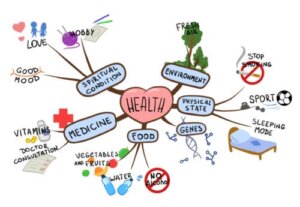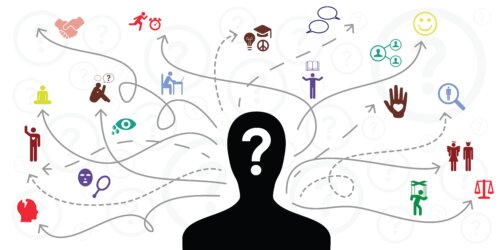Teaching Children How to Make Mind Maps for Studying


Written and verified by the psychologist Ana Couñago
Studying can be a very tedious task for children and adolescents. Therefore, it’s important to teach them certain study techniques to help them assimilate knowledge more easily. In this article, we suggest a strategy of organization and synthesis of information: The elaboration of mind maps.
Among the many benefits of studying with mind maps is the fact that it allows you to have a global and structured view of all the content to be learned.
“Thanks to mind mapping you can turn a long, boring list of information into a brilliant, easy-to-remember, highly organized diagram; your thoughts in tune with your brain’s natural processes.”
-Tony Buzan
What’s a mind map?
A mind map is a study technique based on graphically representing concepts or ideas associated with a given topic or lesson. It’s a tool that facilitates learning, as knowledge is presented in a visual way, relating them to each other through images or symbols and keywords.
Discover more: 7 Study Techniques for Elementary School Kids

It’s about organizing information around a branched structure. That’s to say, a main idea is placed in the center and then complemented with other secondary ideas, which are extracted from the central theme.
“If used in a proper way, mind mapping multiplies reading and learning efficiency by a factor of three – at the very least – and serves to save enormous amounts of time and increase overall reading efficiency.”
-Tony Buzan
Therefore, it can be said that the elements that every mind map should include are:
- A central circle in which the main topic is written
- Keywords linking the information
- Lines or branches
- Eye-catching colors
- Images, drawings, or symbols that favor memorization and recall of all ideas
Teaching children to make mind maps to study
To make a mind map correctly, you need to follow three simple steps:
- Write the main topic and an image that represents it right in the center of the sheet.
- From the central image of the theme, draw branches, preferably in the form of curved lines, with the other concepts and ideas.
- Represent all the ideas or concepts by means of images or symbols and keywords.
“Its construction logic is based on neuronal form, which is why wavy lines are preferred over straight lines, because of the idea that the brain assimilates these forms better than the rigid and geometrized forms of other visual organizers of information.”
-Luis Alberto Núñez
In addition, you need to keep in mind that a mind map should contain few words and be as graphic as possible. Nowadays, to make a mind map, it0s no longer strictly necessary to use a pencil and paper, as there are many computer programs that can be used to carry out such elaboration, such as the following:
- Freemind.
- MindGenius.
- Connected Mind.
- Ideament.
- XMind.
- PersonalBrain
You may also be interested in: 8 Strategies for Better Performance When Studying

The benefits of making mind maps to study
Now that you know how to make mind maps, surely you’re wondering why it’s such a good idea to teach children to study by making mind maps. Here are a few reasons:
- They provide a global vision of the subject to be studied.
- They’re easy to consult.
- They save time.
- They favor recall.
- They allow the separation of relevant information from irrelevant information.
- They optimize the memorization process.
- They serve to clarify ideas.
- They allow you to group large amounts of information in a simple structure.
- They favor concentration and attention.
- They promote planning in the study.
- They promote creativity.
“The traditional way of taking notes, by its nature and structure, doesn’t favor your creativity. Mind maps, on the other hand, using all the resources of your imagination and all the tools of the right and left hemispheres of the brain, allow you to unleash your creativity.”
-Tony Buzan
Mind maps and the development of thinking
In addition to the benefits mentioned above, mind maps are especially useful to encourage children’s analytical and creative intelligence. Whether in analog or virtual form, the tool allows the organization of information with autonomy and spontaneity following certain guidelines.
They become a study technique that cancels automatic rote learning and favors comprehensive memorization. This is because it employs the free association of ideas mediated by graphic references or keywords that work as triggers for the development of thought.
To conclude, as stated in a study published in the International Journal of Educational Research and Innovation, mind maps promote: “the understanding of the contents worked on by students, increasing motivation, participation, and study because it facilitates the process of understanding and synthesis of information, making students the protagonists of their own learning process.
Studying can be a very tedious task for children and adolescents. Therefore, it’s important to teach them certain study techniques to help them assimilate knowledge more easily. In this article, we suggest a strategy of organization and synthesis of information: The elaboration of mind maps.
Among the many benefits of studying with mind maps is the fact that it allows you to have a global and structured view of all the content to be learned.
“Thanks to mind mapping you can turn a long, boring list of information into a brilliant, easy-to-remember, highly organized diagram; your thoughts in tune with your brain’s natural processes.”
-Tony Buzan
What’s a mind map?
A mind map is a study technique based on graphically representing concepts or ideas associated with a given topic or lesson. It’s a tool that facilitates learning, as knowledge is presented in a visual way, relating them to each other through images or symbols and keywords.
Discover more: 7 Study Techniques for Elementary School Kids

It’s about organizing information around a branched structure. That’s to say, a main idea is placed in the center and then complemented with other secondary ideas, which are extracted from the central theme.
“If used in a proper way, mind mapping multiplies reading and learning efficiency by a factor of three – at the very least – and serves to save enormous amounts of time and increase overall reading efficiency.”
-Tony Buzan
Therefore, it can be said that the elements that every mind map should include are:
- A central circle in which the main topic is written
- Keywords linking the information
- Lines or branches
- Eye-catching colors
- Images, drawings, or symbols that favor memorization and recall of all ideas
Teaching children to make mind maps to study
To make a mind map correctly, you need to follow three simple steps:
- Write the main topic and an image that represents it right in the center of the sheet.
- From the central image of the theme, draw branches, preferably in the form of curved lines, with the other concepts and ideas.
- Represent all the ideas or concepts by means of images or symbols and keywords.
“Its construction logic is based on neuronal form, which is why wavy lines are preferred over straight lines, because of the idea that the brain assimilates these forms better than the rigid and geometrized forms of other visual organizers of information.”
-Luis Alberto Núñez
In addition, you need to keep in mind that a mind map should contain few words and be as graphic as possible. Nowadays, to make a mind map, it0s no longer strictly necessary to use a pencil and paper, as there are many computer programs that can be used to carry out such elaboration, such as the following:
- Freemind.
- MindGenius.
- Connected Mind.
- Ideament.
- XMind.
- PersonalBrain
You may also be interested in: 8 Strategies for Better Performance When Studying

The benefits of making mind maps to study
Now that you know how to make mind maps, surely you’re wondering why it’s such a good idea to teach children to study by making mind maps. Here are a few reasons:
- They provide a global vision of the subject to be studied.
- They’re easy to consult.
- They save time.
- They favor recall.
- They allow the separation of relevant information from irrelevant information.
- They optimize the memorization process.
- They serve to clarify ideas.
- They allow you to group large amounts of information in a simple structure.
- They favor concentration and attention.
- They promote planning in the study.
- They promote creativity.
“The traditional way of taking notes, by its nature and structure, doesn’t favor your creativity. Mind maps, on the other hand, using all the resources of your imagination and all the tools of the right and left hemispheres of the brain, allow you to unleash your creativity.”
-Tony Buzan
Mind maps and the development of thinking
In addition to the benefits mentioned above, mind maps are especially useful to encourage children’s analytical and creative intelligence. Whether in analog or virtual form, the tool allows the organization of information with autonomy and spontaneity following certain guidelines.
They become a study technique that cancels automatic rote learning and favors comprehensive memorization. This is because it employs the free association of ideas mediated by graphic references or keywords that work as triggers for the development of thought.
To conclude, as stated in a study published in the International Journal of Educational Research and Innovation, mind maps promote: “the understanding of the contents worked on by students, increasing motivation, participation, and study because it facilitates the process of understanding and synthesis of information, making students the protagonists of their own learning process.
All cited sources were thoroughly reviewed by our team to ensure their quality, reliability, currency, and validity. The bibliography of this article was considered reliable and of academic or scientific accuracy.
- Buzan, T. (2013). Como crear mapas mentales. Urano. Disponible en: https://books.google.es/books?id=ew3NMgEACAAJ&dq=como+crear+mapas+mentales+libro&hl=es&sa=X&ved=2ahUKEwjAlN2SxZ_9AhVwRKQEHdL_Bt4Q6AF6BAgCEAI
- Delgado, C. (2022). Estrategias didácticas para fortalecer el pensamiento creativo en el aula. Un estudio meta-analítico. Revista Innova Educación, 4(1), 51-64. Disponible en: https://www.revistainnovaeducacion.com/index.php/rie/article/view/392
- González, J. M., Carrasco, C. A. & Requena, B. E. S. (2015). La aplicación de los mapas mentales en educación primaria. IJERI: International Journal of Educational Research and Innovation, (4), 70-89. Disponible en: https://upo.es/revistas/index.php/IJERI/article/view/1459/1174
- Novoa, P. F., Cancino, R. F., Flores, W. S. & Nieto, J. (2018). El Mapa Mental Armónico en la comprensión de textos narrativos en estudiantes universitarios. Propósitos y Representaciones, 6(2), 541. Disponible en: https://doi.org/10.20511/pyr2018.v6n2.243
- Núñez, L. A., Novoa, P., Majo, H. & Salvatierra, A. (2019). Los mapas mentales como estrategia en el desarrollo de la inteligencia exitosa en estudiantes de secundaria. Propósitos y Representaciones, 7(1), 59-82. Disponible en: https://dx.doi.org/10.20511/pyr2019.v7n1.263
- Uyaguari, J. (2020). Mapas mentales como técnica para el mejoramiento del proceso de enseñanza-aprendizaje. Runae, 71–82. Disponible en: https://revistas.unae.edu.ec/index.php/runae/article/view/389
This text is provided for informational purposes only and does not replace consultation with a professional. If in doubt, consult your specialist.








